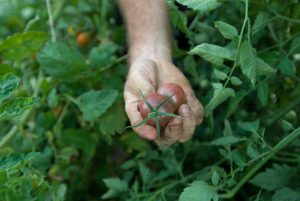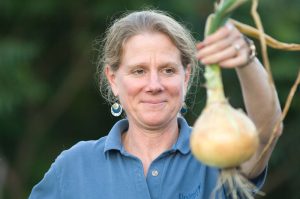Bulletin #4311, Planning and Managing a Community “Giving” Garden in Maine (Sections 1-2)
Starting a Garden Program
First, I applaud your effort to start a garden program. There are several key components that you will want to line up before getting started. You will need land, water, tools, a place to keep your tools, and a picnic table to work at while cleaning vegetables, as well as to sit/rest/talk, etc.
I contacted the staff of the Orono Recreation Center about my idea, and we discussed several possible places to put in a garden. The head of Parks and Recreation suggested we garden in a small (1/2-acre) park area next to the Birch Street Senior Center. We looked over the area and found the soils were good. Soil tests indicated no issues, and we decided to start by tilling up the ground to make raised beds. (See Bulletin #2286, Know Your Soil: Testing Your Soil for more information about testing your soil.)
We did well to work with the town to create a relationship, but our first mistake was to not communicate with the people who lived next to the garden area about our plans. When we started to rototill the grass, two families came out and were very angry at our taking away their kids’ play area. A better effort to reach out to them initially would have likely stopped their concerns, as later this same area became a garden for a different organization with a different purpose.
After a series of discussions, the neighbors thought it was okay for us to use the area behind the Birch Street Senior Center. So, that is what we did. We collected additional soil samples and rototilled the area where the soils were the best, and proceeded to form a series of raised beds. Testing soil is essential to ensure that lead levels are low and to give you a sense of your soil pH and nutrient content. It will also give you a baseline nutrient and organic matter content to follow over time. We do this every 2–3 years to see how our nutrient levels are trending over time.
Volunteers and Volunteer Management
Volunteers are the key to a successful gardening program. Without volunteers you will not get far. There are several keys to managing volunteers:
- provide structure for the volunteers;
- make them feel as important as they are to your program;
- greet them when they arrive, and say thank you to them each day when they finish their time with you;
- bring them treats to eat and drink; and
- recognize your volunteers.
Volunteers really are the key to a successful giving garden program. At the start of every year, we put flyers out to recruit volunteers. I drafted volunteer job descriptions that give them a sense of what is required of them. I have job descriptions for people who want only to garden; those who want only to harvest, wash, bag, and deliver; and for those who want to do both. In the description, I talk about how much is required of them, how many days a week we will work, and the duration of the commitment.
Key Lesson #1
The first lesson is yes, work with your town to identify the right area to establish your garden, but also talk with all surrounding neighbors, and work to get their support and buy-in. Otherwise you will not build community!
If you garden at home, you are the boss. If you want to garden barefoot, that’s your decision. But if you want to do this type of a gardening program where you are responsible, you must have some rules. I have a safety training the first garden day of each year and go over a few rules that are essential to our work:
- If children are going to garden, their parents must be with them at all times.
- All garden volunteers must wear intact, closed-toed shoes.
- I encourage the use of insect repellents to reduce chances of tick-borne illness (I don’t make people wear bug repellent, but I discuss tick concerns).
- I discuss safe tool management (tools sharp-side down, return at end of session).
- I point out the location of the first-aid kit and its basic use.
- I demonstrate the safe and ergonomic way to use garden tools.
Children should be exposed to gardening early to appreciate what it takes to grow food and have fun in the garden. That said, children allowed to run around unsupervised would not be helpful to anyone’s garden operation. You want the gardening experience to be fun, relaxing, and pleasant for everyone with good discussion opportunities. Children with their parents overseeing them are less likely to have issues, bother people, or get hurt. We have followed this rule closely without an issue.
When you have sometimes 10 or 12 people working, tools can become hazards. I ask that all tools be left vertical with sharp ends or points down in the soil when not in use. Rakes must be left tine down in the ground. I also try to get people to work effectively with tools and not hurt themselves. Using proper body position and taking full advantage of the leverage of the tool will help people reduce the chance of back or other injuries. I warn them on the first evening that I may pester them about such things. If you see people gardening with very poor posture, most appreciate learning how to use the tools to the best effectiveness.
Volunteer appreciation is key. Many people want to try to help out in their community. Helping to provide food is a good medium through which to provide help. It is important to realize that while people want to be helpful, most have limited time. Volunteers need to know they can leave early if they need to. They need to know that being there every week is not essential, but you also need a critical mass to make it feel like you are making progress. Food is a must. I usually buy a half-dozen homemade cookies at the farmers market to bring for the Saturday workday. I also try to buy fruit when I can purchase it locally from our farmers market. Often, just a taste of a strawberry or a slice of melon goes a long way to make volunteers feel appreciated. Finally, at the end of the year, my wife and I put on a party for the volunteers. We cook food, have drinks, and give out awards for the longest serving volunteer, most social volunteer, best new gardener, and gardener of the year. Following this type of volunteer management program, you will be more likely to have volunteers return year after year.
Every giving garden will require volunteers. The actual numbers of volunteers depend on many factors including experience and stamina. It is impossible to say if you must have 6, 12 or 18 volunteers to make a project happen. Starting out a giving garden project, I would want a minimum of a dozen volunteers, and six with some gardening experience. To do a harvest and delivery in a three-hour period requires a minimum of six volunteers. If you can get 15 to 18 interested people who can come most weeks, I believe you will have a sufficient amount of staff to make a go of this.
In complying with the letter and spirit of applicable laws and pursuing its own goals of diversity, the University of Maine System does not discriminate on the grounds of race, color, religion, sex, sexual orientation, transgender status, gender, gender identity or expression, ethnicity, national origin, citizenship status, familial status, ancestry, age, disability physical or mental, genetic information, or veterans or military status in employment, education, and all other programs and activities. The University provides reasonable accommodations to qualified individuals with disabilities upon request. The following person has been designated to handle inquiries regarding non-discrimination policies: Director of Institutional Equity and Title IX Services, 5713 Chadbourne Hall, Room 412, University of Maine, Orono, ME 04469-5713, 207.581.1226, TTY 711 (Maine Relay System).



